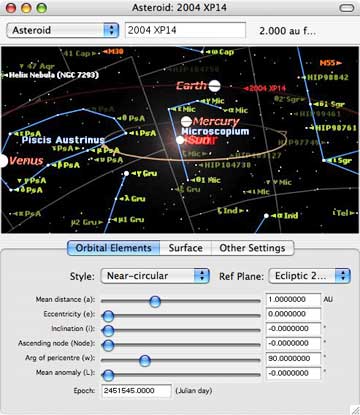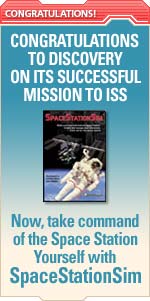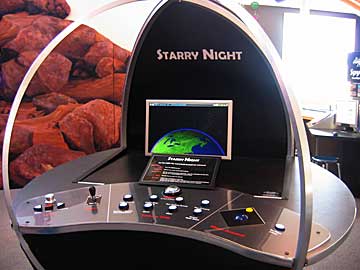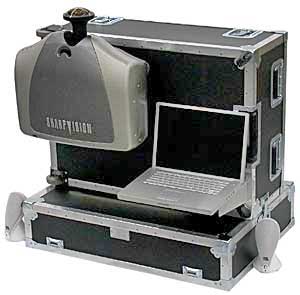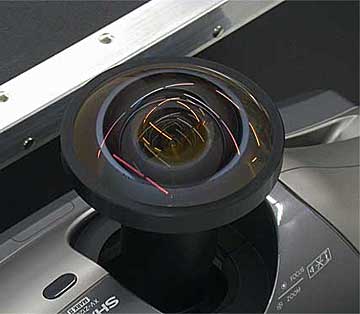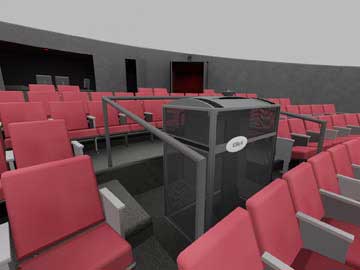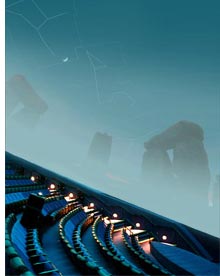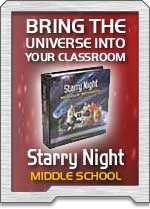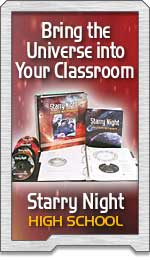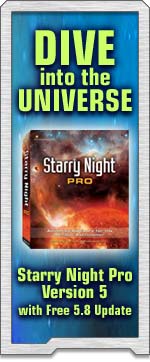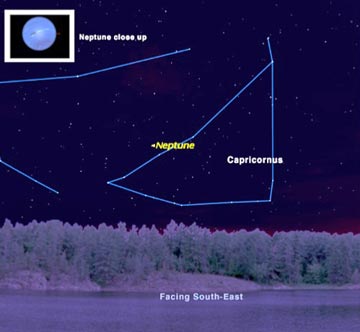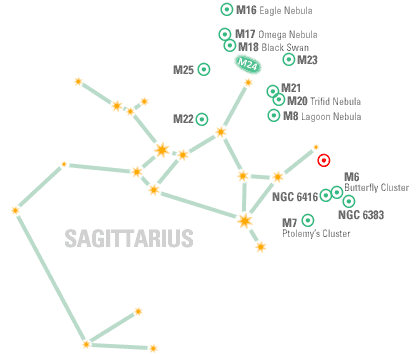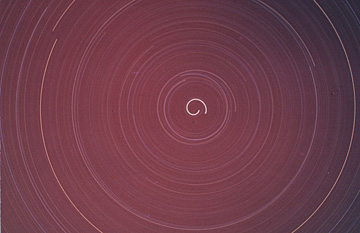 |
||||||||||||||||||||||||||||||||||||||||||||||||||||||||||||||||||||||||||
|
If you have trouble viewing this newsletter, click here. Welcome again to our monthly newsletter with features on exciting celestial events, product reviews, tips & tricks, and a monthly sky calendar. We hope you enjoy it!
In our last issue, we alerted you to the impending close passage of near Earth asteroid 2004 XP14. Although many people tried to observe this object, I seem to be one of the few who actually succeeded. Here’s how I managed it. One essential for observing a faint fast moving body is to know exactly where it is going to be. The easiest way to do this is to use Starry Night® to plot its path. The problem with near Earth asteroids is finding accurate up-to-date orbital elements. Because near Earth asteroids pass close to the Earth, their trajectory across the sky is very slight until they are very close, because they are coming pretty well straight at us. This makes it very hard to define their orbit until they are nearly on top of us. Also, because they are small and passing close to large objects like the Moon and the Earth, their orbits are often perturbed at the last moment. The trick is to use the most recent elements calculated just a few hours prior to the pass. The orbital elements in the Starry Night® data files are updated every 24 hours, and are good for almost every object. However, because this asteroid could change quickly, I wanted elements that were updated only a few hours before I went out to observe, so I decided to use elements from the IAU's Minor Planet Centre downloaded a few hours before the pass. All you need to do here is type in the asteroid’s name, in this case “2004 XP14,” tell it (down towards the bottom of the page) that you are using Starry Night®, and click the “Get ephemerides/HTML page” button. In Starry Night®, you choose “New Asteroid Orbiting Sun” from the File menu, and paste the values from the MPC web page into the boxes:
You should give the asteroid a name different from the one already in Starry Night®; otherwise Starry Night® will use its own elements to replace the ones you’ve entered. I printed out a series of charts at half hour intervals along the track. I figured that the earliest I could observe the asteroid was at 01:30 am EDT (2006 July 02 05:30 UT) when it was just clear of the trees to my northeast. I set up my 11" Newtonian with a Nagler 22mm eyepiece, yielding a magnification of 63x and a field of view of 1.3 degrees. The transparency was poor, the Milky Way being just barely visible overhead. I aimed my telescope for the point where the asteroid was predicted to be at 01:30, and waited for it to cross my field of view. Nothing. I tried the same at 02:00, and again came up empty. I began to suspect that the MPC elements were off, so I switched back to the Starry Night® elements and tried again at 2:30. Again, nothing. In a previous observation of a near Earth asteroid some years ago, I recalled that I'd almost missed it because the asteroid was way ahead of its predicted position, so I located the spot where 2004 XP14 would pass at 03:00, through a nice little bat-shaped asterism centered on 1 Persei. I was on target at 02:50. Almost immediately I noticed a tiny speck of light motoring along. I quickly glanced at my watch and saw the time was 02:53 (06:23 UT), no idea how many seconds past. The asteroid was a full eight minutes ahead of schedule! I looked back in the eyepiece and caught a second glimpse a bit further along the path, then lost track of it. It was much fainter than I had expected, no more than 10th magnitude judging by the stars around it, and moving very fast. On rechecking the Starry Night® predictions, I saw that Starry Night®'s prediction had the path right, but it showed the asteroid in the position I observed at a time of 03:01. I rechecked the predictions from the MPC elements and they were even worse: the track was shifted to the northeast and the position was off by eleven minutes! In the morning I located the elements I now know I should have used, on the JPL Horizons web site. These elements are a bit trickier to enter, because they use different terminology and abbreviations than Starry Night® does, but I figured them out by comparing the numbers with the ones in Starry Night®:
When I entered these elements into Starry Night®, both the track and the times were in very close agreement with what I observed. Given the inaccuracy of the predictions I was using, it's a miracle I saw the thing at all. What saved the day was choosing a spot well ahead of the predicted position and then waiting in ambush for it to pass through. For the record, the asteroid was 444,424 km away when I spotted it, as compared to a distance of 405,624 km to the Moon. Starry Night® is a great starting point to help you plan your observations. Since fast moving objects are unpredictable, it's always a good idea to download elements calculated just a few hours before the pass and input them into Starry Night® as a back-up plan. Geoff Gaherty |
August 2006
|
|||||||||||||||||||||||||||||||||||||||||||||||||||||||||||||||||||||||||
|
If you think Starry Night® on a 20-inch screen is impressive, imagine it on a 30-foot dome. That dream is no longer far from reality. In the past two years, Starry Night® has collaborated with leading science centers and planetarium makers to bring the visual beauty and accuracy of Starry Night® to larger screens and audiences. In January 2006, the Sciencenter of Ithaca, NY opened the doors to its new interactive exhibit, Mars and Stars, which features a hands-on Starry Night® kiosk. Children can visit astronomical objects such as planets, stars, and nebulae, and see the constellations in our local night sky with the push of a button.
Photo courtesy of Sciencenter The kiosk at the Ithaca Sciencenter is running a modified version of Starry Night® Pro that was designed to have a simpler user interface for museum visitors. Visitors can press a button to take a trip to the Moon, Mars, and other astronomical objects. They can pull a lever to zoom, or manipulate a trackball to move around in space. Visitors are also able to watch the sunrise and set over the Sciencenter and view the night sky throughout the year. The Mars and Stars exhibition also includes exhibits on infrared imaging of planets and stars, exploring Mars, investigating color and light, magnetic constellation activity, a Mars landscape mural, a reading area, and beautiful Hubble Space Telescope images. The exhibition was made possible with the generous support of the NASA NY Space Grant Consortium, the NASA Education and Public Outreach program through Cornell University scientists, and the Space Telescope Science Institute. For more information about the Sciencenter, visit
Digital STARLAB Starry Night® planetarium shows may be coming to a school near you. Starry Night® has been working with Learning Technologies, best known for their STARLAB inflatable planetariums, to provide an all-in-one digital planetarium system for use in portable or small fixed domes. The Digital STARLAB, available from Learning Technologies, made its premiere last fall at several science and technology conferences. In keeping with the philosophy of existing products from Learning Technologies, Digital STARLAB encourages interactivity and hands-on, minds-on learning through its curriculum, activities and programs.
Photo courtesy of Learning Technologies, Inc. Using a laptop interface, powered by a customized version of Starry Night® called Starry Night® Small Dome, users can choose from a set of 12 pre-scripted, national standards-based lessons or two full curriculum modules that are included with the system. The first curriculum module explores five Native American cultures and their knowledge and beliefs about solar and lunar astronomy, based on Astronomy of the Americas from Volume 11 of the Planetarium Activities for Student Success. The second module Giant Leaps, based on The Powers of 10, is a valuable tool for teaching and understanding the universe through the concept of scale.
Digital STARLAB features a patent-pending fish-eye lens capable of depicting an accurate, high-contrast, simulated night sky. Users can explore a multitude of motions and displays without the need for additional slide projectors, video projectors, sound systems or computers. Covering a full 180º on the dome, the small bright stars remain spherical right down to the horizon. Its superior contrast creates a truly black background making the star images even more realistic. There are no cutouts or blind spots along the horizon. The projector is compact, lightweight and easily transported. For more information about the Digital STARLAB...
Spitz SciDome™ If you are lucky enough work in a large planetarium, then Spitz SciDome™, powered by Starry Night®, is what you want to bring your museum or science center into 21st century. SciDome is recommended for planetariums with dome diameters up to 45 feet (13.5 meters). At the core of SciDome is a single high resolution video projector displaying SXGA resolution graphics. Similar to a digital cinema system, the hemispheric fish-eye lens of the SciDome projector creates bright, colorful imagery that covers the entire dome.
Photos courtesy of Spitz Inc. A true "digital planetarium," SciDome combines real-time 3D sky simulation, pre-recorded full-dome shows and classical planetarium special-effects. SciDome offers educators unparalleled teaching capabilities and the flexibility of a desktop planetarium. The intuitively designed user interface puts powerful control at the operator’s fingertips. All commands are executed graphically. The presenter can change views of the sky, display constellations and coordinates, find sky objects and even fly through space just by clicking icons on the control screen. No scripting is required, allowing educators to concentrate on astronomy, not a complex command line interface. Because it is compatible with desktop versions of Starry Night®, instructors and educators can develop lessons, activities and assignments anywhere - at home, in the classroom or on the road. SciDome can also be controlled remotely, via the Internet, from anywhere in the world. SciDome includes a library of astronomical, educational and special-effects imagery properly formatted for full-dome display. Most clips are 30-40 seconds long and suitable for use in Sky Tonight shows, lessons, or as special effects in automated shows. Imagery includes stars, galaxies, planets, and other astronomy simulations. Visit a Spitz SciDome powered by Starry Night near you! Eastern US
Central US
Western US
Outside US
For more information about the Spitz SciDome...
Linda Fung |
|
|||||||||||||||||||||||||||||||||||||||||||||||||||||||||||||||||||||||||
|
Spitz Digital Institute Starry Night® has partnered with Spitz Inc for the second annual Digital Institute, an expanded five-day program in which teachers and planetarium professionals can explore astronomy education, presentation and production techniques using Starry Night® and other digital tools. Courses will cover a broad range of digital planetarium topics from basic techniques and terminology, to advanced lesson creation with 3D simulation software and advanced-user sessions. The Digital Institute will focus on using software to enhance education in both the classroom and the planetarium, with a particular emphasis on the following critical areas:
The Institute is divided into two parts. The first two days (August 15-16) are open to any teacher or planetarium professional interested in teaching with Starry Night®. Courses focus on how Starry Night® is used to bridge classroom astronomy education with planetarium presentations. Educators work with Starry Night®'s existing lesson plans and develop their own activities. The advanced three day session (August 17 - 19) is meant specifically for planetarium presenters, producers, educators and directors. Sessions focus on how to produce shows and present live astronomy demonstrations using Starry Night® Dome. Participants will learn Photoshop to prepare and format still images that can be displayed within Starry Night®, basic digital audio editing, time-line automation, and how to find digital resources. Participants will break into teams for the Digital Institute “Space Race”. Teams of 5 – 6 people will conceive, script, prepare, produce and present an educational planetarium program within one day. These three days will also be an opportunity for experienced Starry Night® Dome users to receive advanced trainings and present workshops. Registration is closed for this summer’s session, but contact Joyce Towne of Spitz (610-459-5200) for more information on next year’s session. Starfest Canada's largest annual observing convention and star party celebrates its 25th anniversary this August. Sponsored by the North York Astronomical Association, it attracts over 1,000 astronomy enthusiasts from Ontario, and neighboring provinces and states. It has been ranked among the top seven star parties in North America by Sky & Telescope magazine. Starfest offers a wide variety of observing-oriented activities that address the needs and interests of experienced observers and astrophotographers, as well as those new to the hobby. Activities include observing sessions, formal and informal presentations, workshops, commercial exhibits, and a children's program. You are invited to bring your telescope and astronomical images, and share your observing experiences with others. Stop by the Starry Night® booth or join us for a 3-hour workshop, “Starry Night® Pro for Today’s Observer,” or 1-hour presentation on using Starry Night® in the classroom.
Starry Night® Pro is a powerful tool for observers and imagers. In this workshop, you will learn how to use Starry Night® for observation - planning and logging, charting, simulation and wireless telescope control. Starry Night® ensures your observing sessions are fun and productive. A trial version of Starry Night® Pro will be provided to workshop attendees. Full version copies can be purchased at a substantial discount.
Starry Night®'s innovative new astronomy education packages integrate hands-on and computer activities to provide complete learning experiences. Participants will learn how to use Starry Night® software to meet the needs of a variety of learners as they address the expectations in the Earth and Space strand of the Grade 6-12 Curriculum. For Starfest registration information, visit: Linda Fung |
|
|||||||||||||||||||||||||||||||||||||||||||||||||||||||||||||||||||||||||
|
Neptune spends most of the year in the constellation Capricornus. On August 11th it reaches opposition and, although low in the sky, this marks the best time to observe the eighth planet from the Sun.
At Neptune’s distance, the Sun appears less than 4% as bright as it does at Jupiter. So Neptune is invisible from Earth to the naked eye and a challenge to detect even with a good pair of binoculars. At magnitude 7.7 and featuring a very tiny (2.5 arc-second) bluish disc, at least a six-inch telescope and a magnification of 150x are required to reveal it as a planet. Neptune’s largest moon, Triton, shines with a magnitude of 13 and can be glimpsed in a six-inch telescope but only under near-perfect conditions. Pedro Braganca |
||||||||||||||||||||||||||||||||||||||||||||||||||||||||||||||||||||||||||
|
M6 and M7, two open clusters, are bright and obvious in Sagittarius, and make for easy binocular objects. Telescopes open up both in rich detail and M6 is seen to be aptly named "The Butterfly Cluster". NGC 6416 is a small open cluster and NGC 6383 is a dim, wide cluster with nebulosity. M8 "The Lagoon Nebula" is the brightest nebula after the great Orion nebula. It's actually more massive than M42 but is farther away: 4,500 lightyears distant compared with 1,500 lightyears. M8 is best viewed with a wide-field eyepiece. Less spectacular, but still worth some time, M20 "The Trifid Nebula" is also easily seen in binoculars; a telescope will bring out the dust band that gives the nebula is shape and name. M21 is a small rich open cluster in the same field of view as M20. M23, excellent in small scopes, is an open cluster seen in binocs, as is M25. M24 "Delle Caustiche" is a large and lovely "frothy" looking region seen easily in binoculars. It's actually part of the Milky Way and only stands out as a distinct patch because, like M23 and M25, it sits in front of a dark nebula that obscures our line of sight to the core of the galaxy. (By the way, the very center of our galaxy is marked above with a red target symbol.) M22 is a sweet globular cluster, the third-brightest in the sky. Populated by half a million stars, it's distant by a mere 10,000 lightyears, making it the nearest glob to Earth. M16 and M17 are two nebulae, the latter in particular a rewarding target. M16, however, is notable for being the location of "The Pillars of Creation" the iconic image produced by the Hubble Space Telescope. M18 "The Black Swan" is a pretty open cluster with about 40 members, surrounded by fainter background stars in the band of the Milky Way. Sean O'Dwyer
|
||||||||||||||||||||||||||||||||||||||||||||||||||||||||||||||||||||||||||
|
24-hour Star Trails This month’s winning photo was taken by Earl Moser from Hickman, Nebraska (submitted by daughter - Leona Barratt , Lincoln, Nebraska). Earl writes:
PHOTO OF THE MONTH COMPETITION: We would like to invite all Starry Night® users to send their quality astronomy photographs to be considered for use in our monthly newsletter. Featured submissions (best of month) will receive a prize of $25 USD. Please read the following guidelines and see the submission e-mail address below.
|
||||||||||||||||||||||||||||||||||||||||||||||||||||||||||||||||||||||||||
 |
||||||||||||||||||||||||||||||||||||||||||||||||||||||||||||||||||||||||||
|
|
||||||||||||||||||||||||||||||||||||||||||||||||||||||||||||||||||||||||||
You have received this e-mail as a trial user of Starry Night® Digital Download
or as a registrant at starrynight.com. To unsubscribe, click here.
